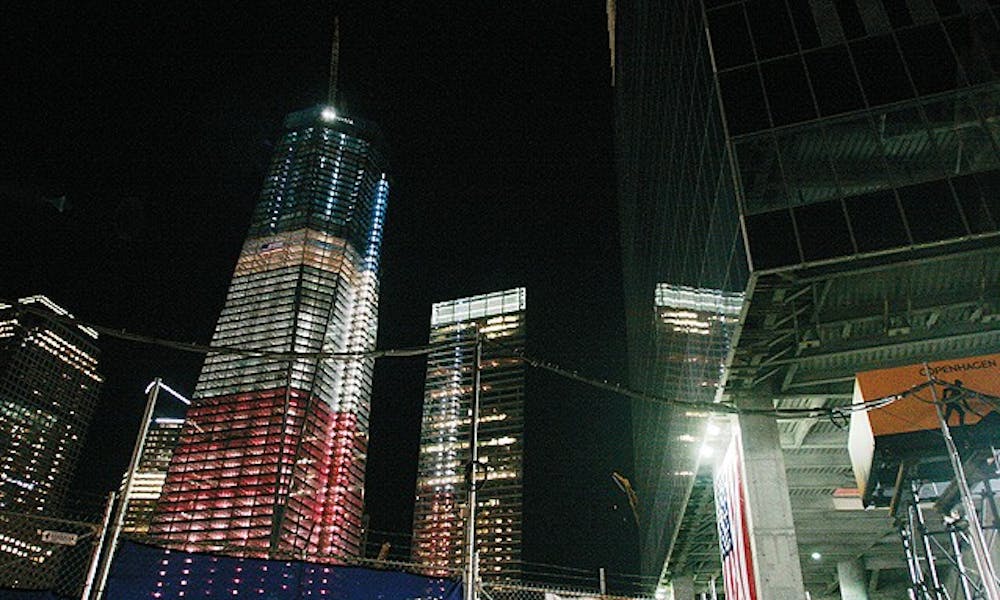I’m on the second floor of the expansive Time Warner Center in the heart of Manhattan. All around me are life-size photographs of individuals with fierce looks in their eyes. There are firefighters and paramedics and ironworkers, all frozen in a moment in time.
Photographer Joe McNally captured these images in the months following 9/11 using the world’s only giant Polaroid camera. They’re on display here now in this glossy commercial space, set against new digital images of the same individuals in an exhibit called “Faces of Ground Zero, Portraits of the Heroes of September 11, 2001.” The faces in the new photos show ten years worth of lines, but the eyes are the same.
One woman stands in front of a decade-old photo of a group of New York City high school students. “There’s one thing I notice,” she says to her friend. “They all look so angry.”
I look on with her, but I’m not sure if it’s anger I see.
These images and their accompanying narrative captions tell tales of tragedy and bravery, of chance and loss. But it’s disorienting to take them in, because as a solemn stream of visitors makes its way through the more than 50 photos spread out across the atrium, a much larger flood of shoppers surges past without a glance at the images. Up the escalator they go, on their cell phones, toting their purchases from J. Crew. Meanwhile, elevator music plays loudly in the background.
To my left, a woman with close-cropped hair reads the sign next to a photo of Kevin Scanlon, Firefighter, Squad 18, FDNY, who lost dozens of his peers in the attacks. I watch her as she looks up, and there’s a tear in the corner of her eye. Yet, to my right, dozens of neon signs cover the window of a Borders store—“70-80% Off! Going Out of Business! Closing Sale!”
I’m not sure how this makes me feel. But when it comes to me and 9/11, that’s nothing new.
It’s become a cliché to say where you were on the morning of September 11, 2001, to relive the memory of a tragedy, rooted in a particular time and place. The fact is, I’m not even sure where I was that morning. I know I was back home in Miami. I assume I was in school, probably sitting in drama class. I do remember excitedly writing what had happened in my diary: “Today two planes flew into the World Trade Center buildings in New York. All these kids were taken out of school. They are saying on the news that it was terrorists. A lot of people have died.” I imagined myself a sort of Anne Frank, one day documenting my crush of the week and the next writing of death and tragedy. But fundamentally, I felt a disconnect from what had happened, and that’s continued to this day.
I had hoped that being in New York for the memorial would make me finally get it. I had hoped that I would be made to feel the pain of the families of those who lost their lives, that I would understand what New Yorkers went through, that I would remember a time when our country was united behind hurt and anger and pride, rather than torn apart by partisanship. But when I took the E Train to Lower Manhattan, “World Trade Center” flashing on the screen to signify the train’s final destination, I felt like I was arriving on a movie set. Narrow cobblestoned streets, skyscrapers, Asian tourists snapping photos. I stood in front of the bronze sculpture of a tree at Trinity Church—a sculpture built from the roots of a giant sycamore knocked over by wreckage on 9/11. It’s like something out of Narnia, I thought, and then I felt guilty.
So now, back at the Time Warner Center, I stand in front of a life-size photo of a man in a janitorial uniform. He has thick eyebrows and thin lips, and I have to tilt my neck back to meet his eyes. “Jan Demczur,” the sign by the photo reads. “Window washer.”
The sign tells Demzcur’s story. He was trapped in an express elevator on the 50th floor of the World Trade Center on September 11, 2001. Demczur used the handle of his squeegee to pry open the elevator doors and cut a path through the drywall of the elevator shaft. He and the others in the elevator managed to squeeze through this hole and escape from the building, minutes before the tower fell.
There’s a quote by Demzcur at the bottom of the sign. “I can’t talk about it,” it reads.
I know what you mean, I think to myself.
It’s been ten years since 9/11 and I’ve had half my life to reflect on a tragedy, and I still don’t know what to say.
Get The Chronicle straight to your inbox
Signup for our weekly newsletter. Cancel at any time.

